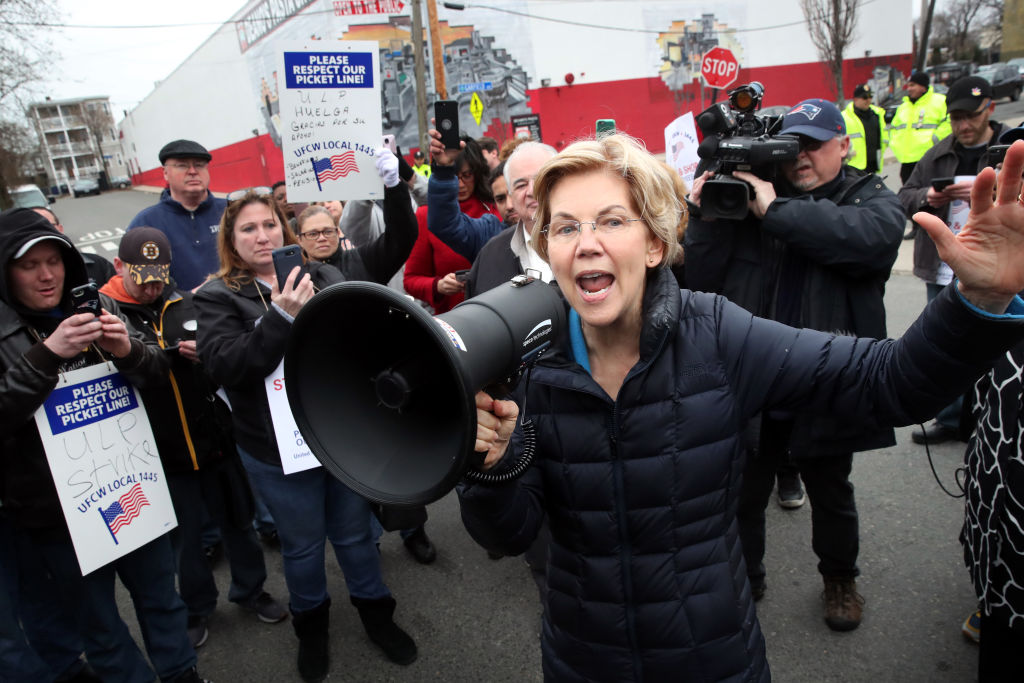
Source: Boston Globe / Getty
Early on Monday, April 22, presidential hopeful Senator Elizabeth Warren announced an ambitious higher education plan that would include free public college, a massive student loan debt forgiveness program, funding for Historically Black Colleges and Universities, and eliminate federal funding for allfor-profit colleges.
Any single one of these components would effect change in the American higher education system, but taken together, Warren’s plan would transform higher education as we know it into a completely different beast. One that actually works for students and consumers and helps build up our nation through education-for-all.
In her twitter announcement, Warren wrote, “This is the kind of big, structural change we need to make sure our kids have opportunity in this country.”
She expanded upon that sentiment in her Medium post, writing, “Higher education opened a million doors for me. It’s how the daughter of a janitor in a small town in Oklahoma got to become a teacher, a law school professor, a U.S. Senator, and eventually, a candidate for President of the United States.”
But there’s a big difference between saying you want to completely change a multi-billion dollar industry and actually doing it. So how would Warren’s plan work?
What Is She Proposing?
Warren has proposed a multi-prong overhaul of the higher education system to do two things:
- First, address the existing financial burden on students and former students.
- Second, create programs that will ensure a crisis like this never happens again.
And she’ll do this in several stages.
Cancelling Student Loan Debt
First and foremost: she’ll address the current student loan debt crisis. To put things into perspective, according to Student Loan Hero, “Americans owe over $1.56 trillion in student loan debt, spread out among about 45 million borrowers.” For the class of 2018, students graduated with an average of $29,800 in student loan debt, and the average monthly payment is $393. And while the case has been made for zero percent interest student loan repayment, Warren’s plan is a little different.
Per her announcement, she is calling for “the cancellation of up to $50,000 in student loan debt for 42 million Americans.”
But it’s not just a matter of wiping the slate clean to the tune of $50,000 for all student loan borrowers. Instead, her plan would cancel $50,000 of student loan debt for households earning $100,000 or less. There is also debt cancellation for households earning more money, proportionate to income level.
- For households earning between $100,000 to $250,000, her “$50,000 cancellation amount phases out by $1 for every $3 in income above $100,000, so, for example, a person with household income of $130,000 gets $40,000 in cancellation, while a person with household income of $160,000 gets $30,000 in cancellation.”
- For households earning $250,000 or above, there would be no debt cancellation.
But how would this work? Would she just wave a magic wand and, poof, debt be gone? Kind of, but in an actionable sense: using pre-existing data collected about student loan borrowers, outstanding loans, and income, the Warren plan would automatically eliminate debt. Finally, borrowers wouldn’t have to file their cancelled debt as income, which means they wouldn’t be financially punished for keeping a larger portion of their income the year the forgiveness went into effect.
And in order to prevent another student loan crisis, Warren would enact the next stages of her plan.
Funding HBCUs and Pell Grants
Warren has proposed funding two programs that are essential to lowering barriers to success for low-income individuals:
- $100 billion over 10 years toward Pell Grants, need-based, non-tuition grants for low-income individuals in higher education.
- $50 billion over 10 years toward Historically Black Colleges and Universities (HBCUs), schools that were formed during segregation, sometime before 1964 (the end of Jim Crow and other racist laws), specifically to educate African-American students.
For many years, Pell Grants were the ticket to economic stability for low-income students. When the grant program was started in 1972, needy students were able to take upwards of $5,620 and put it towards non-tuition costs, which meant a greater likelihood of graduating. Now, 47 years later, the maximum Pell Grant is only $5,920, and the American dollar does not go nearly as far as it did in 1972. Why would this help prevent a future higher education crisis? As Warren points out: non-tuition grants help bolster graduation rates and close earnings gaps between lower- and higher-income individuals.
As for HBCUs and Minority Serving Institutions (MSIs), as of 2017, approximately 300,000 students attended Historically Black Colleges and Universities (HBCUs), 80 percent of whom were African-American and 70 percent of whom came from low-income backgrounds. HBCUs have a positive economic impact, both on the students who attend these institutions and the people who work for and near said institutions, and they also help close the graduation gap between black students and demographic groups. According to Forbes, “HBCUs are credited with creating the American black middle class. The report states that HBCU’s have produced 40% of African-American members of Congress, 40% of engineers, 50% professors at PWIs, 50% lawyers, and 80% of judges.”
Warren’s plan would implement a spending floor of $50 billion, but the Secretary of Education would have the power to increase that number.
Eliminating Funding For Predatory Institutions
For-profit colleges have been part-and-parcel of the student loan crisis. They’re predatory institutions that have fueled the student loan crisis by making bold promises about the power of four-year degrees, using that promise to overcharge students (many of whom come from low-income backgrounds) for cut-rate educations, and offering predatory private loans in order to fund said education, which in turn do not turn into high-paying jobs as promised. 52-percent of graduates from for-profit and not-for-profit colleges defaulted on their student loans after 12 years, according to Money, and these institutions disproportionately target military personnel and students of color, which has exacerbated economic gaps among communities of color.
Warren’s plan is simple: “After an appropriate transition period, ban for-profit colleges from receiving any federal dollars (including military benefits and federal student loans), so they can no longer use taxpayer dollars to enrich themselves while targeting lower-income students, service-members, and students of color and leaving them saddled with debt.”
As of yet, there’s no word on how she’s going to define the transition period, but by stripping federal funding from these institutions, Warren will be able to do two things:
- Help prevent some of the most vulnerable students from spending money on educations that won’t increase their economic power
- Put more money into accredited, public institutions that do help job seekers.
Making Public College Free
Making higher education free or extremely low-cost would help close the racial wealth gap, so Warren has proposed treating higher education like K-12 education by making two- and four-year public colleges free. She’d do so in part by splitting costs for tuition and fees between the federal and state governments.
She also has smaller components to her plan which will lower barriers to success and make the economy work for people across ethnicity, age, and other demographics. One example? She’ll ban public colleges from considering citizenship and criminal history in admissions decisions. The latter is particularly important: study after study has shown that higher education reduces recidivism.
READ MORE: Uproxx.com
Article Courtesy of Uproxx
First Picture Courtesy of The Washington Post and Getty Images
Second Picture Courtesy of Boston Globe and Getty Images
First and Second Tweet and Third and Fourth Picture Courtesy of Twitter and Uproxx
How Elizabeth Warren Is Proposing to Get Rid of Student Loan Debt was originally published on wzakcleveland.com

















